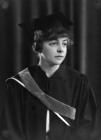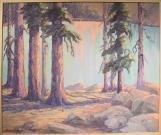2
Vaughan Grayson's earliest art education came during her childhood by means of a local artist named Gertrude Rorason. She went on to receive more official education in her post-secondary years at the Curry School of Expression, but here she specialised in acting, rather than painting. More direct artistic tutelage came from Marion Long at St. Margaret's College. Though formal training as a professional artist seems to have been limited, she did study art education at Columbia University.4
Upon returning to Moose Jaw, she began her career as an art educator. She was appointed as art curriculum advisor for the Moose Jaw Public School Board. She held that position briefly before moving to Regina to become an instructor of art at the Normal School teacher's college. In 1929, she returned to Moose Jaw again to become Director of Art at the Normal School there.5
Picture Appreciation for Elementary Students1929
Moose Jaw, SK
 Credits:
Credits:Moose Jaw Museum & Art Gallery
6
She wrote two books on art appreciation for students. The first was Art Appreciation, published in 1929; it became widely circulated and went into a second printing in the 1930's. It was directed at elementary school students, and it was made up of a series of art lessons based around significant European and Canadian works.7
Picture Appreciation for Elementary Students (inside)1929
Moose Jaw, SK
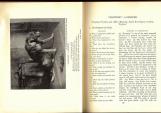 Credits:
Credits:Moose Jaw Museum & Art Gallery
8
The book involved a simple analysis of art. A picture would be featured, and Grayson would put forth 15-25 questions regarding its subject, its composition, and its meaning. Students were meant to consider these questions. However, the book also included Grayson's own answers to these questions, which would often be put forth in a terse, matter-of-fact way. Questions are often leading or rhetorical, and her answers border on a sort of rote-based dogmatic approach which reflects the heavily structured education system in the 1930's. It appears she was trying to relate to the young students by her simple phrasing and also the demure, child-like intonation which laces much of her description. The questions also make multiple references to the colours in the composition, though the pictures appeared in the book in black and white.In addition to this, she also suggests student exercises related to the painting, and makes comparisons with other pictures, as well as correlations with different media, such as music and poetry.
9
Picture Appreciation for High School Students1932
Moose Jaw, SK
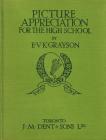 Credits:
Credits:Moose Jaw Museum & Art Gallery
10
Picture Appreciation for the High School was the second of her books, published in 1932, and still widely circulated, though not as popular as the first.11
Picture Appreciation for High School Students (inside)1932
Moose Jaw, SK
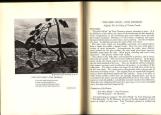 Credits:
Credits:Moose Jaw Museum & Art Gallery
12
This book involves a more complex approach to works of art, indicating Grayson's development as an art educator and a greater respect for the older students. Rather than a long list of questions and accompanying answers, she gives several paragraphs of interpretation, which is not expressed in the same matter-of-fact, absolute sense. She poses a few analytical questions, but this time does not answer them for the student. She draws correlations between the artworks and pieces of poetry, prose, and music, most likely stemming from her elocution training.She describes Tom Thomson as painting "after the manner of the modern school". Her interpretation of his "The West Wind" is that it is "an intangible theme, expressed through the design and pattern of the mountain, lake, and trees," foreshadowing her prolific use of those three subjects later in her career.
